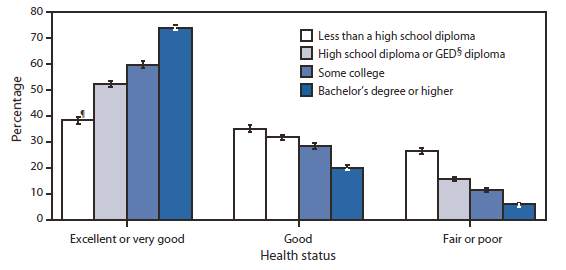Persons using assistive technology might not be able to fully access information in this file. For assistance, please send e-mail to: mmwrq@cdc.gov. Type 508 Accommodation and the title of the report in the subject line of e-mail.
QuickStats: Health Status* Among Persons Aged ≥25 Years, by Education Level --- National Health Interview Survey, United States, 2009†

* Health status data were obtained by asking respondents to assess their own health and that of family members living in the same household as excellent, very good, good, fair, or poor. Data are presented only for family members aged ≥25 years.
† Estimates are based on household interviews of a sample of the U.S. civilian noninstitutionalized population. Denominators for each category exclude persons for whom data were missing. Estimates are age adjusted using the projected 2000 U.S. population as the standard population and using four age groups: 25--44 years, 45--64 years, 65--74 years, and ≥75 years.
§ General Educational Development.
¶ 95% confidence interval.
The percentage of adults aged ≥25 years whose health was reported as excellent or very good increased as levels of education increased. Persons with a bachelor's degree or higher (74.1%) were nearly twice as likely to be reported as being in excellent or very good health as persons with less than a high school diploma (38.3%). Persons with less than a high school diploma were approximately four times more likely than those at the highest educational level to be reported as being in fair or poor health. The same pattern was observed, but to a lesser extent, for those in good health.
Sources: National Health Interview Survey 2009 data. Available at http://www.cdc.gov/nchs/nhis.htm.
Adams PF, Martinez ME, Vickerie JL. Summary health statistics for the U.S. population: National Health Interview Survey, 2009. Vital Health Stat 2010;10(248). Available at http://www.cdc.gov/nchs/data/series/sr_10/sr10_248.pdf.
Alternate Text: The figure above shows the health status among persons aged ≥25 years, by education level in the United States in 2009. According to the figure, the percentage of adults aged ≥25 years whose health was reported as excellent or very good increased as levels of education increased. Persons with a bachelor's degree or higher (74.1%) were nearly twice as likely to be reported as being in excellent or very good health as persons with less than a high school diploma (38.3%). Persons with less than a high school diploma were approximately four times more likely than those at the highest educational level to be reported as being in fair or poor health. The same pattern was observed, but to a lesser extent, for those in good health.
Use of trade names and commercial sources is for identification only and does not imply endorsement by the U.S. Department of
Health and Human Services.
References to non-CDC sites on the Internet are
provided as a service to MMWR readers and do not constitute or imply
endorsement of these organizations or their programs by CDC or the U.S.
Department of Health and Human Services. CDC is not responsible for the content
of pages found at these sites. URL addresses listed in MMWR were current as of
the date of publication.
All MMWR HTML versions of articles are electronic conversions from typeset documents.
This conversion might result in character translation or format errors in the HTML version.
Users are referred to the electronic PDF version (http://www.cdc.gov/mmwr)
and/or the original MMWR paper copy for printable versions of official text, figures, and tables.
An original paper copy of this issue can be obtained from the Superintendent of Documents, U.S.
Government Printing Office (GPO), Washington, DC 20402-9371;
telephone: (202) 512-1800. Contact GPO for current prices.
**Questions or messages regarding errors in formatting should be addressed to
mmwrq@cdc.gov.


